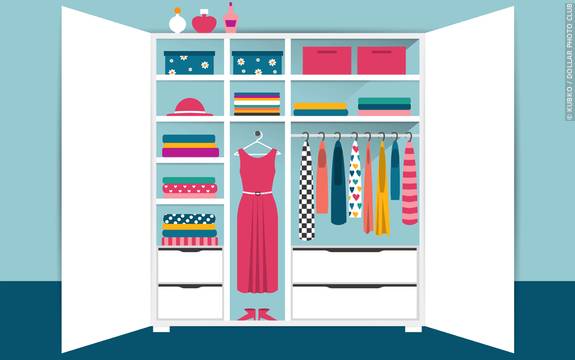Fashion Psychology: What clothes say about you
The psychology driving our clothing choices and how fashion affects your dating prospects.

You needn't be an avid fashionista, nor a London Fashion Week regular, to be aware of how important our dress sense is to our reputations in the 21st Century. The clothes we wear send powerful signals to our peers and strangers, projecting the self image of us that we want to display.
Yet, how many of us truly understand the psychology of how people in the street or office interpret our wardrobe choices, and how this impression might differ to the one that we believe we're conveying to them?
An array of psychological surveys have revealed the true impact of clothing choices on the way in which we perceive and judge each other, with experiments showing some surprising results. They even reveal how subtle varieties in dress sense can affect our ability to attract a partner whilst we are dating.
Defying stereotypes
Against the gender stereotype of females being more fashion-aware and conscious of others' clothes and makeup efforts than males, studies have also lifted the lid on men's insecurities with regards to clothes.
Contrary to commonly held beliefs, men have been shown to be often more self-conscious than females with regards to their personal dress sense and the way in which they are viewed in public (Solomon and Schopler, 1982).1
Therefore, we need to understand the significance of clothing choices regardless of our gender. Whether you are male or female, your fashion choices can affect both your self image, the impression that you convey to others and in turn, the way in which people behave towards you. They can influence everything from the outcome of a sports match (Hill and Barton, 2005) to an interviewer's impression of your ability to perform effectively in a job position (Forsythe, 2006).23
In this article, we look at the effect that our fashion choices today can have on our lives, and how our unconscious clothing choices are interpreted by those around us.
Why clothes matter: what your wardrobe says about you
Clothes have not always been as influential a 'tell' of our personalities as they are today. Only as a result of technical advancements over centuries have fashion choices become significant.
Where in early civilizations, the key purpose of clothing was to keep us warm and relatively dry, today, central heating warms our homes, reducing our dependence on clothes alone to help us to survive. Clothes have developed from a practical asset to a social marker: they affect the way we see ourselves. They help us to be seen in the light that we wish to be, and also exude our personalities and social status.
In many societies, dress sense embodies personal wealth and taste. For example, Economist George Taylor demonstrated this most vividly with the Hemline Index (Taylor, 1926).4 Taylor noted that as a country enters recession and adopts austere spending habits, women often show a preference towards longer dresses, whilst during times of prosperity, the opposite result can be seen - hemlines often become shorter.
A second key influence on our dress sense is a result of millions of years of development as a species. As with many animals, the concept of mate selection in evolutionary psychology suggests that our behavior is determined by our efforts to find a mate and to reproduce.

According to signalling theory, a male peacock will display his vibrant fan of covert feathers in a ritual to attract a female with whom to mate. Such rituals vary from species to species, but in humans, our ability to create and wear clothes gives us a equivalent advantage in being able to distinguish ourselves from a crowd and demonstrate our individuality in an effort to find a mate. Conversely, too, we might use clothing to merge into a crowd and hide our individuality by dressing in a uniform.
Dressing to Impress?
Aside from the adage of "dressing to impress" what do we know about the psychology of clothing choices in relation to dating?
Firstly, let's consider the idea of how we seek to 'impress' potential partners. A study by Joseph Benz at the University of Nebraska surveyed more than 90 men and women with regards to the way in which they deceive potential partners whilst on dates. The researchers found that both genders tend to use deception when dating but for different purposes.
Males were found to try to impress their dates by emphasizing the security that they could offer the partner - for example, by exaggerating their financial position or by trying to demonstrate a preparedness to commit. Women, however, were deceptive with regards to their body image, exaggerating physical features in an effort to appear more attractive to their date (Benz et al, 2005).5
In both cases, clothing may play a part in this dating ritual of deception.
Another factor in our clothing choices is the way in which males and females perceive and interpret different colors.
In one experiment, researchers photographed people in different colored clothes and then asked participants to rate the attractiveness of people in the resulting photos. They found that the color of clothing affects the way in which men rate both males' and females' attractiveness, and how women rate men's attractiveness. Interestingly however, clothing color did not influence women's judgement of other females (Roberts et al, 2000).6
This brings us to the question: which colors are viewed as attractive?
Roberts and his fellow researchers found that red clothes would tend to lead participants to rate subjects more favorably in terms of attractiveness compared to when they wore clothes of other colors.
This result might explain the findings of a study which found that, when waitresses wore different colored t-shirts whilst serving in a restaurant, men would tend to leave higher tips for those wearing red tops than those with t-shirts of other colors. However, shirt color had no effect on the tips left by female customers (Guéguen and Jacob, 2010).7
Learn more about the psychology of color here
Of course, the color of garments is far from the only factor used in judging a person based on clothing.
Timothy Brown and his fellow researchers of the Department of Psychology at Old Dominion University looked at the effect of clothing on college students' judgement of both people's attractiveness and masculinity or femininity.
Brown found that in both genders, posture and the way in which people moved influenced perceptions of their masculinity or femininity, which was intrinsically linked to their judgement of their attractiveness.
Specifically in males, tight-fitting clothes as opposed helped lead to perceptions of increased masculinity over those who wore baggy garments (Brown et al, 1986).8
Naturally, many of the findings from research into the psychology of fashion and clothing choices are subject to the cultural values of the society in which a person lives. Cultural differences in the interpretation of color, for example, mean that red may be perceived to have different qualities to those valued by participants in Guéguen and Jacob's waitress experiment, depending on the country a restaurant is situated in.
We should also note that the superficiality of clothing choices are rarely the sole determinant of how people are perceived: Brown's study into clothing and attractiveness demonstrated the influence of body language in addition to clothing choices. And for those of us with limited fashion sense, as the English writer William Hazlitt cautioned, "Those who make their dress a principal part of themselves, will, in general, become of no more value than their dress".

No comments:
Post a Comment